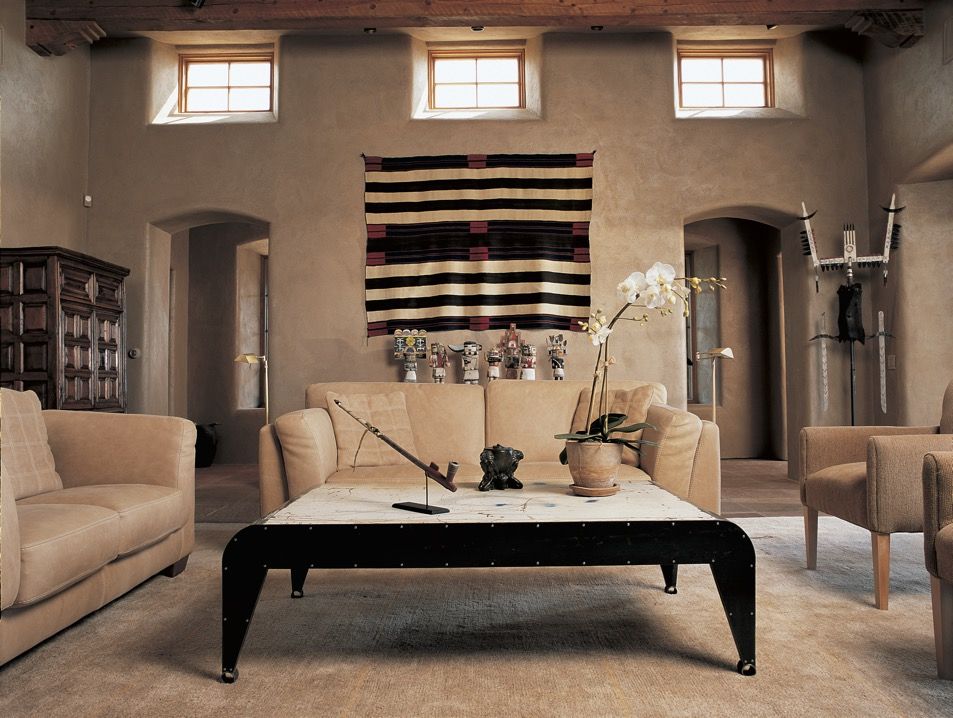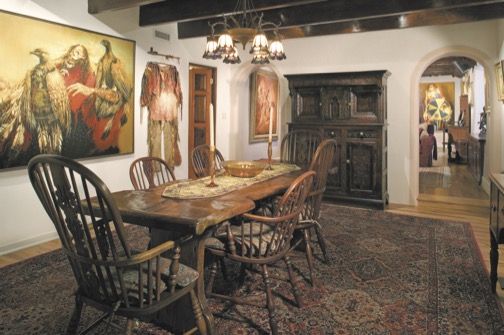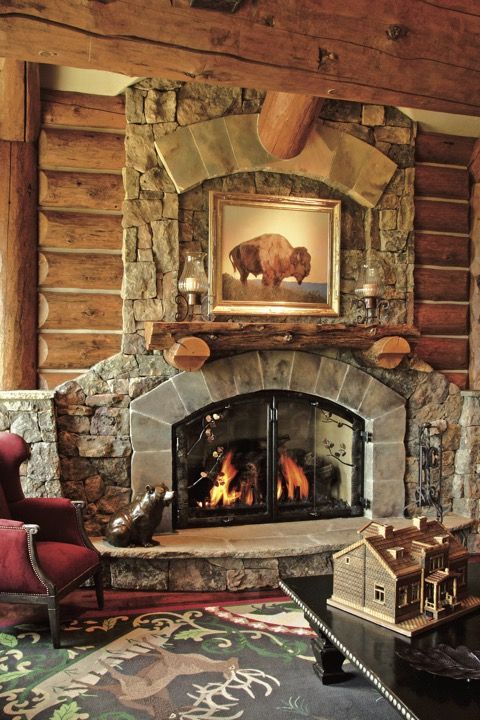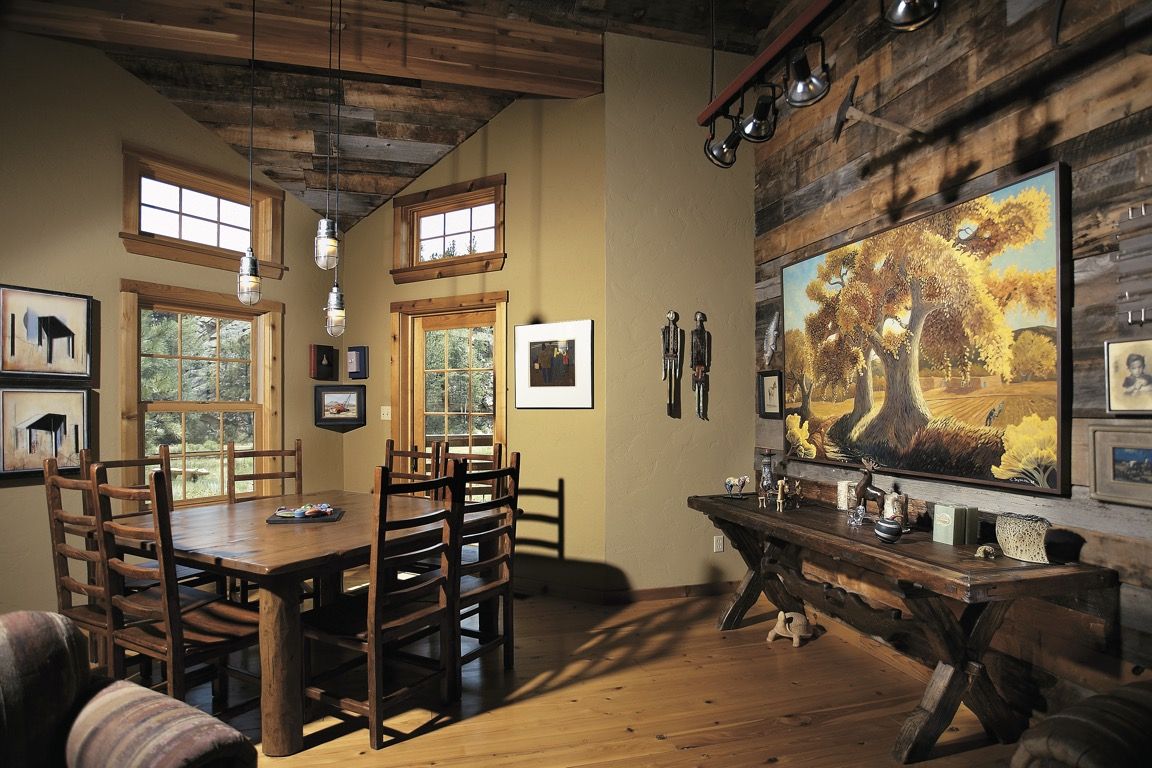In each issue of Southwest Art, we bring you hundreds of images of top-notch artworks: paintings and sculptures from established and emerging artists, with subject both western and nonwestern, most of which are for sale at galleries, shows, and auctions across the West. But there’s another side to collecting that goes beyond the artwork itself—what does it look like in your home? To answer that question, we dug into our archives for our favorite stories on great collections and selected some beautiful rooms where art was most definitely the star of the show. Let them be an inspiration on your art-collecting journey.
Museum Quality

Photo: Clay Ellis
In this modern home in Santa Fe, with its high ceilings and earth-toned walls, the collector, who chose to remain anonymous, indulged his love of historic textiles from southwestern tribes, as well as numerous other Native American artworks and artifacts. The living room shown here was home to a beaded Crow war shirt, three classic Navajo blankets, a selection of Hopi kachinas, and a magnificent necklace ringed with bronzed bear claws that belonged to a Red River Cree warrior almost 200 years ago. Elsewhere in the home were even more treasures, including early-20th-century Cochiti Pueblo drums, Indian belt buckles, paintings, and sculpture.
Though the quality of the pieces and their dramatic presentation were museum-worthy, prestige couldn’t have been further from the collector’s mind. “The pleasure is in living with them and looking at them every day,” he said. “I find Native art and culture remarkable.”
Ancient Adobe

Photo: Jack Kotz
The 300-year-old adobe home of the late artist Ed Morgan (1943-2014) and his wife Virginia in Taos, NM, was a festival of art, iron, and wood. In the dining room shown here, a large painting by Paul Pletka was a major focal point. It was one of many western artworks in the collection, which also included paintings by Don Crowley, Howard Terpning, Robert Griffing, William Acheff, and many more well-known names, as well as countless Indian artifacts. The dining room was also home to a 17th-century English pub table whose surface was full of scars and notches.
“You can’t have a pub table you can’t stick your knife into after a good meal,” said Morgan, joking in earnest. “You don’t own these things, you just care for them,” he told us about his extensive collection of art and objects. “We’re only going to pass all this along anyway. We’re just maintaining history here. We’re caretakers. Still, that’s the great thing about having them: I can wander around here and just look at these great paintings.”
Honoring the Environs

Photo: Heather MacArthur
When Tim Eller, then the chairman and CEO of Dallas-based homebuilding company Centex Corporation, decided with his wife Kathy to build a home in Colorado’s Vail Valley, designing specific places for an art collection was a central focus. The unusual thing, though, is that when the Ellers began working with their architect and builder on plans for a Colorado mountain-style house, they owned only a modest art collection.
They expanded their collection exponentially over a decade, eventually acquiring some 100 pieces, mostly paintings by such artists as John Moyers, Terri Kelly Moyers, James Reynolds, Laura Robb, Gerald Fritzler, Edward Aldrich, and Wayne Wolfe. They added large, compelling sculptures by Dave McGary and Dan Ostermiller, too. The unifying focus of the collection was that “almost everything looks as if it could have been painted within a 100-mile radius of the home. Everything has the ‘feel’ of this geographical area,” Kathy Eller explained. One of their prized pieces, a John Moyers called LAST OF THE BUFFALO DAYS, hung over the great-room fireplace shown here.
Earthy & Eclectic

Photo: Seth Hughes
The home of collectors Will Sibbald and Leland Brown was nestled in a valley in southern Colorado. The home was built to their specifications and turned out to be exactly what they dreamed: an exterior that resembles an old mine that had been on the property, and an interior finished with stone, hardwood floors, and neutral tones of paint. They even bought an old barn from a neighbor, had it disassembled, and used the wood to cover the cathedral ceiling and two walls of the great room.
Because the house was so subtle and earthy, their eclectic collection of art and objects blended remarkably well. In small mountain-town galleries, they had purchased gigantic tools by sculptor Carl Stransky. At the Art for the Sangres benefit exhibit, as well as shows at the Sangre de Cristo Arts Center in Pueblo, CO, they encountered artists who became favorites such as Elizabeth Sandia, Sean O’Meallie, Kim Mackey, Ann Huston, and Ed Sandoval, whose large landscape dominates the room shown here.
This story appeared in the October/November 2021 issue of Southwest Art magazine.





